
table of contents
- Why is repotting important?
- The ideal time to repot bonsai
- What time of the year should you repot bonsai?
- frequently asked Questions
bonsai-Trees are normal trees that have been turned into small trees through certain measures. To keep them small, they should be repotted regularly. But when should you repot the bonsai? We'll tell you the best time.
In a nutshell
- Repotting is important for the health of the bonsai
- generally repot after 3 to 5 years
- Rotational growth of the roots as a characteristic
- ideal time: early spring
Why is repotting important?
Repotting goes with that Cut back the roots and branches hand in hand. Both are important for the health of the bonsai. Especially for
- the oxygen supply in the soil
- the acid balance of the soil
The reason for this is the small bowl of the bonsai. This takes root quickly. As a result, there is less space for air pores in the earth. These actually supply the tree with oxygen from the soil. The earth, which settles more and more over time, further reduces the number of air pores. In addition, dense and moist soil leads to the fact that the carbon dioxide produced during cell respiration dissolves in the water. Carbonic acid is produced. This gradually acidifies the soil. These factors lead to
- Shortening the distance between the leaf nodes on a shoot
- short term: better flowering
- Braking growth
- The bonsai will die off

Note: In the case of old-looking trees, this can underline the character. Therefore you should postpone the repotting time of these bonsai for another year. The longer you wait to repot, the more difficult it becomes.
The ideal time to repot bonsai
In general, the ideal time to repot a bonsai is estimated to be between 3 and 5 years. However, this is not universal. It also applies:
- Transplant young plants after 1 to 2 years
- older bonsais with slow root growth 1 to 2 years longer than regular
- Bonsais in rapidly decaying substrate faster than trees in structurally stable soil
The decisive factor for repotting is not how long the tree is in the bowl, but how much the soil is compacted. You should therefore check once a year by taking your bonsai out of its bowl. If the roots grow in a circle around the ball (twisting growth), you should repot the bonsai soon. If the roots are still in the ground, you can wait another year. Further characteristics of compacted soil are:
- Tree grows slower than typical
- Soil hardly absorbs water when it is poured
- The root ball is pushed up out of the shell
But there are also other times when it makes sense to repot the bonsai:
- New purchase
- Mold / algae formation
- diseased leaves despite watering and ideal location
- Salinization of the bonsai soil (e.g. B. after overfertilization)
- excessive pest infestation

Note: Do not repot your bonsai just because one of the points has been met. Observe the plant growth carefully and then weigh up whether repotting is really necessary. Repotting too often can also have disadvantages.
What time of the year should you repot bonsai?
For almost all bonsai species, early spring is the ideal time to repot. In Germany, this corresponds to the period from around the end of February to the beginning of March. It is important that the following criteria are met:
- Permanent frosts over
- not too warm yet
- Tree about to shoot
Then the bonsai is still in hibernation. In the meantime, it survives repotting better. In individual cases, mainly with conifers, bonsais are not repotted until the end of summer. By then, however, the midsummer heat should already be over. In Europe you should only repot directly in summer if absolutely necessary. You also have to put the bonsai in a greenhouse for a few weeks to grow.
Note: In Asia, some tree species are repotted after flowering (May to June). Because of the high humidity there is no problem there. However, this is not recommended in Germany.

Be careful not to repot the bonsai at the wrong time. This has a negative effect on the growth of the bonsai:
- too early: slow healing of the interfaces
- too late: water and nutrient supply suffers
- too often: no / poor regeneration of the roots
frequently asked Questions
Yes, it is even recommended. Shorten the roots and, if necessary, branches until the tree is the desired size. In this way, new, short fine roots grow back, which improve the tree's absorption capacity. In addition, the root system becomes more compact.
No. An initial fertilization should take place after four weeks at the earliest. Before that, the bonsai draws the necessary nutrients from the new soil. However, since it is susceptible to pests after repotting, you should not expose it to direct sunlight or drafts. A shady, sheltered place is ideal.
Maybe. In principle, the bonsai is adapted to the bowl, not the other way around. Therefore, the old bowl can usually be used again after cleaning. The bonsai should be as flat and small as possible. A new bowl is only suitable if the tree has become much larger or smaller and is supposed to stay that way. In general, the length of the bowl should be about 2/3 the height of the tree.



